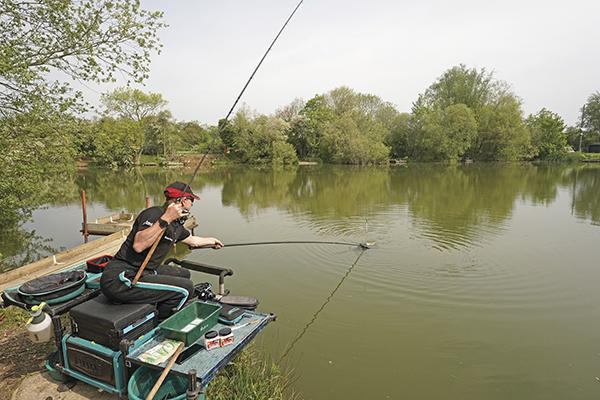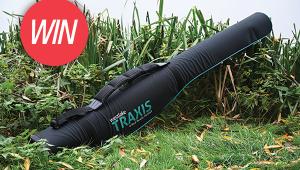Slide your way to success!

When it comes to tackling deep water venues – 10 foot plus – beyond pole range, you only really have two options: Feeder fishing, or break out the slider float. As an international angler – I fish for the Welsh team – I don’t have a choice really as feeder fishing isn’t allowed in international float fishing competitions. So the slider is a tactic that I have had to learn and master! Although, saying that, once you get a few little bits right there is very little to master really. Plus, in my opinion, there is no better way to spend a day’s fishing than catching bream on a slider float. Having grown up in South Wales, I spent my salad days fishing on venues like Llangorse and East Dock in Cardiff, all places that are very deep and so the slider became the ‘go-to’ tactic. I think that fishing it a lot in my formative years, is why I love it so much these days.
The Beauty Of The Slider
Long forgotten and rarely used these days, due to its wrongly perceived difficulty to fish well, slider float fishing is almost like feeder fishing, but with more possibilities available to the angler I reckon. There is much more you can do with a slider than you could ever do with a feeder set-up. For those of you that have never encountered the slider, briefly it does what it says on the tin! The slider involves the use of a large, heavy, bodied float, which once cast is set up in a way so it is able to slide up the main line, allowing you to easily fish deep waters with all the sensitivity, flexibility and sheer enjoyment of watching a waggler.
As a tactic, it has received a lot of bad press over the years, as many anglers reckon it’s too difficult to bother with. True, the feeder is an easier method in this situation, but it is also very one-dimensional. You can only fish hard on the bottom and you’re forced to feed every cast too. Unless of course, you swap over to a bomb. Using the slider float gives you many more presentation options. Also as long as you follow a few simple rules, the slider is as easy to fish as a standard waggler. The main problem I find is that anglers tend to look at it as another float setup and so try to fish with complicated shotting patterns or too light a float. These easily rectified problems are what sees these anglers tangling every cast prior to throwing the rod up the bank before going back to their trusty feeder rod. By making just a few tweaks, you can cast a long way all day without a single tangle.
The Advantages Of The Slider?
Known as a deep water (generally any swim over 10 feet) technique, the slider can also be used to great effect on shallower lakes if they are badly affected by tow. You can even fish it on the river too if you want. It’s a very versatile tactic. Like I said, the method involves using a semi-loaded, large, bodied float, which once cast in, slides up the main line to a stop knot tied at swim depth, enabling the angler to fish deep water easily.
A bulk of large shot, or an olivette if you prefer, provides the main weight to pull the main line through the float’s bottom eye so it ‘slides’ up the line. Once the stop knot is reached, the bulk will register; cocking the float then the dropper shot will allow the hook bait to fall naturally to the lake bed, trimming the float’s bristle perfectly.
Fishing this way offers a number of advantages. The first is that you are able to fish well beyond pole range. Today I’m at Haverholme Park Lake in Lincolnshire, where I’m fishing a swim around 40 metres from the bank. The beauty of the slider is I can fish at range, but unlike a pole, which sees you missing bites very often in deep water, when the fish feel the weight of the float, the slider, although much cruder, is much more sensitive. As well as ‘sailaways’, you also get very positive lift bites too.
This is certainly an advantage when targeting skimmers and roach, which can give very delicate bites. These will be positively registered on a float, whereas feeder tactics may see you missing bites or reeling in the dreaded skinned maggot hook bait! The second advantage is that feeder tactics are very static, as the hook bait is laid hard on the bottom. With a slider float, you can move the shot about to create a faster or slower fall of the hook bait through the water, tailoring the approach to the way the fish are feeding and giving the perfect presentation for any given day or swim. You can also flick the line, so twitching the float and the hook bait to entice a bite also.
Thirdly, unlike feeder/bomb fishing, the slider can be fished from well overdepth to three feet under the surface, depending upon where the fish are. And finally, I find there is a pleasing aesthetic to be had from watching a float and the water, rather than having your eyes cast down, staring at a quivertip. It is just more enjoyable to watch a float and work for bites, altering shot and feed patterns, rather than chucking out a feeder and waiting ages for it to ‘maybe’ wraparound.
Slider Tackle
Starting at the rod, I use a 14ft Acolyte Plus float rod. The extra foot brings a lot of advantages, especially when casting I find. Plus, it has a lovely soft tip but plenty of backbone for playing bigger fish. The beauty of the longer rod also allows you to lob the cast rather than punching the float out. Casting like this helps to prevent tangles.
The next step is the main line. I use 5lb Drennan Feeder line as it sinks well and, being a little stiffer, it also helps prevent tangles on the cast and when the float is sliding, particularly in very deep water. When it comes to floats, I tend to use three different ones. I like DJK sliders, Daiwa Slider Carpers and Drake floats. The important thing is to use a dedicated slider float if possible, the reason being they are designed for this tactic. They are part loaded, very buoyant – so they slide well – and heavy. You need all these things so the tactic works well.
Regarding the size of float, this all depends upon where you are looking to fish and the depth of water. Just like ordinary waggler fishing, select a float that will get to where you need it with an effortless cast without going too heavy. The slider is just like waggler fishing really, only on a bigger scale. The great thing about using a dedicated slider float is that the eye at the base of the float is a diamond shape. This prevents it from slipping over the slider knot, which is the part of the setup that sets the depth at which the float will fish. If the float goes over the knot, there is nothing to stop it from sliding up the main line further, and so it won’t cock. You can always place a small glass or plastic bead between the float and the knot to prevent this happening. Don’t use a rubber bead though, as these won’t slide along the main line very well, ruining the overall presentation.
Shotting Patterns
This is where most anglers fall down. There is no room for finesse with the slider fishing as this will only lead to tangles. Starting at the important part – the bulk – four to six big shot are ideal, or an olivette for neatness. This offers a compact length of shotting ideal for smoother casting. Importantly, the bulk must be pushed together as tight as you can get it. There don’t want to be any gaps between the string of bulk shots as this is also a tangle problem. Plus, I like to taper my shot from largest to smallest towards the hook, again for neatness.
I set the bulk two feet from the hook, so I can cast very easily too. I then have one small bulk of dropper shot just over the length of the float, again to prevent tangles. This is normally three or four No8s. This is the slider and not a pole rig. There is no need or room from complex shotting patterns as this only leads to tangles again. Crude and simple is the way forward with this tactic. I then cast ‘off the bulk’, with the float sitting on top of the shot, but, if your style doesn’t suit this, you can place a small shot just over a float length up the main line, so the float sits around 40 centimettess from the bulk if you find this easier to fish and cast. Below the small droppers I have a No8 swivel to prevent the hook link from spinning up, and this also acts as a final dropper shot too.
Bait Choice
As I’m ideally after bream today, my tactic revolves around groundbait. My mix is a combination of three Evolved Baits’ groundbaits. The first being a 50:50 mix of Sweet Fishmeal Black and Irish Gold. These make the perfect silver fish mix for me regardless of the type of venue I’m fishing on. But, as I’m fishing at range, I need to use a groundbait catapult to get the balls accurately into the swim as they are beyond balling in range. This means they need to be a bit stickier than normal, and so to the initial mix I add Big River, in a 70:30 ratio. The addition of Evolved Baits’ Big River helps the balls to bind and so as well as getting to the bottom intact, I can also lace them with particles to give the fish something to graze over. To further increase this binding power, I have added Silverfish Liquid Additive. This is quite thick so as well as the powerful flavour and scent trail it provides in the water column, it adds to the groundbait’s stickiness without affecting its overall breakdown rate.
Fishing The Slider
The first thing to learn is that casting a slider is different to all other forms of float fishing. Always fish to the line clip so the rig lands in the same place every time and straightens out. As soon as the float hits the water, you then need to wind four or five turns of line on to the reel and then quickly open the bail arm allowing the line you’ve just wound on to peel off. This allows the bulk to pull the main line through the base of the float. When the stop knot hits the float, the bulk will register and the float will cock, cocking further as the droppers take effect. Once the float has totally cocked, close the bail arm and you’re fishing. To kick off the swim I then feed the groundbait. This will change every day, depending upon what you are faced with, but as today is hot and still I have erred on the side of caution and only fed 12 small balls at the start.
If I was in Ireland for example, or conditions were more favourable, I might kick off with two or three kilos of groundbait. The thing with big bream especially is they don’t like feed coming down on top of them when they are settled and feeding, so it’s better to prime the swim prior to starting. The merits of every day need to be taken in and a decision made, which only you can do on the day. The skill is now making the balls uniform in size so they catapult the exact same distance every time. Accuracy is everything when slider float fishing. Once the swim is fed, I tend to re-feed after every fish, just to freshen the swim but not spook the shoal hopefully! Apart from this though, the slider is no different from any other float setup. It’s really easy to slide your way to success, as long as you keep things quite crude and don’t overcomplicate the approach, especially the shotting pattern. Once you start to fish the slider correctly and understand how it works, you will be fishing it like a pro in no time.
- Log in or register to post comments













